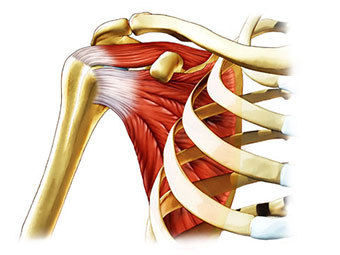ROTATOR CUFF TEAR

A tear in the tissues connecting muscle to bone (tendons) around the shoulder joint. A rotator cuff tear often occurs in people who repeatedly perform the same shoulder motions.
A partial or complete rotator cuff tear makes it difficult to raise and move your arm. You may have shoulder pain and arm weakness. Rotator cuff injuries are common, especially as you get older. Rest, pain relievers and physical therapy can help. Some people need surgery to reattach a torn rotator cuff.
What is the rotator cuff?
The rotator cuff is a group of muscles and tendons in your shoulder. They help you lift and move your arms away from your body. The rotator cuff keeps the ball of the upper arm bone (humerus) in the shoulder blade socket.
What is a rotator cuff tear?
The shoulder is a ball-and-socket joint that’s part of the skeletal system. It’s like a golf ball sitting on a golf tee. Rotator cuff tears occur when tendons pull away from the arm bone. A tear may result from overuse or another injury.
What are the types of rotator cuff tears?
Types of torn rotator cuffs include:
- Partial: With an incomplete or partial tear, the tendon still somewhat attaches to the arm bone.
- Complete: With a full-thickness or complete tear, the tendon separates completely from the bone. There’s a hole or rip in the tendon.
What causes a rotator cuff tear?
An accident, such as a fall, can cause a broken collarbone or dislocated shoulder that tears the rotator cuff.
More commonly, rotator cuff tears occur over time as the tendon wears down with age and use (degenerative tear). People over 40 are most at risk.
Causes of degenerative tears include:
- Bone spurs: Bony growths can form on the top of the shoulder bone. These bone spurs rub against the tendon when you lift your arm. This shoulder impingement creates friction between the bone and tendon. Eventually, a partial or complete tear may occur.
- Decreased blood flow: Blood flow to the rotator cuff decreases as you get older. Your muscles and tendons need a healthy blood supply to repair themselves. If blood doesn’t nourish the tendons, they can tear.
- Overuse: Repetitive shoulder movements during sports or on the job can stress muscles and tendons, causing a tear.
What are the symptoms of a rotator cuff tear?
Sudden tears from accidents cause immediate, intense shoulder pain and arm weakness. With degenerative tears, you may have mild pain that improves with over-the-counter pain relievers. Over time, the pain gets worse, and pain relievers don’t help. Not everyone has pain, but most people have some degree of arm and shoulder weakness.
Signs of a rotator cuff tear include:
- Difficulty and pain caused by raising your arm.
- Popping or clicking sounds or sensations when moving your arm.
- Shoulder pain that worsens at night or when resting your arm.
- Shoulder weakness and struggling to lift items.
How is a rotator cuff tear diagnosed?
Your healthcare provider will perform a physical exam to check for shoulder tenderness, range of motion and arm strength.
To confirm a diagnosis, you may get:
- An X-ray to check for arthritis or bone spurs.
- An MRI or ultrasound to look for tendon tears.

